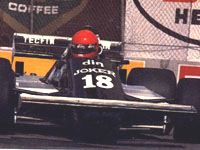World Champion's punching bag
Author
- Mattijs Diepraam
Date
- 8W March issue
Related articles
- 1981 Spanish GP - The Villota farce, by Mattijs Diepraam/Felix Muelas
- March - Customer care, by Mattijs Diepraam
- Ian Scheckter - The older but not the faster Scheckter, by Mattijs Diepraam
Who?Eliseo Salazar What?March-Cosworth 811 Where?Long Beach When?1981 US West GP |
 |
Why?
March's second coming was certainly more by name than by heritage. Or by performance.
In fact, its comeback was the result of a cooperation between March founder Robin Herd and the RAM team of John MacDonald. With the Concorde Agreement outlawing private entries from 1981 on, the last of the privateers had to look for a constructor willing to field its first design of its own. It found a cooperative spirit in Robin Herd's March operation, which after its demise late 1977 had turned its focus back onto its production facility and was about to expand successfully to the overseas CART and IMSA series. In a construction similar to Larrousse fielding Lolas and Scuderia Italia shopping at Dallara, March Engineering entered the 811s for 1981, with RAM actually running the cars. The design was modelled to the all-conquering FW07 but the end result was it neither looked like a Williams nor performed like it. The only Chilean to make it to F1, Eliseo Salazar thus had to face a steep climb uphill.
For Salazar, who had got used to winning in the last Aurora championship, ironically doing it in a RAM Williams FW07, his first real F1 experience brought nothing but sour grapes. The first few GP meetings proved disastrous for the March image, Salazar and team mate Daly (here also seen at the team's debut at Long Beach) getting nowhere with the 811. This led to the engagement of none other than Adrian Reynard to patch up the worst parts of the car. Slowly, the 811 improved during the season, but by then Salazar had taken his Din money to Ensign, collecting an unexpected 6th at Zandvoort. Rather curiously, the 811 formed the basis for the more successful 81C Indycar, marking the beginning of March domination in the category.
In Europe, there were high hopes for 1982, MacDonald signing Jochen Mass and Brazilian youngster Raul Boesel for a Rothmans-backed campaign but the team got noticed best for being involved in Gilles Villeneuve's fatal Zolder accident, Mass mistakenly swerving his 821 onto the Ferrari's racing line. With Mass leaving, RAM oldtimer Rupert Keegan had big shoes to fill, a 22nd qualifying spot in the Swiss GP his best result. Effectively a private effort but entered as a works car to avoid Concorde trouble, a third LBT-sponsored 821 was entered for Emilio de Villota in several GPs on the old continent. Also a man with a RAM past, this was the Spaniard's most serious and lasting foray into the World Championship.
In 1983, after having had his one minute of fame by getting kicked and punched by Nelson Piquet at the Hockenheim trackside for moving his ATS across in front of the World Champion's leading car at one of the chicanes and taking them both out, Salazar returned to the RAM fold, taking the seat in the first RAM-named chassis, the RAM March 01. But again his season with MacDonald was cut short, the Chilean thrown out after four straight failures to qualify. This time, no-one took Salazar on the rebound, Eliseo forced to look overseas to further his career.
In America, he built up a long-time relationship with CART team boss Dick Simon and followed the merged Scandia-Simon team into the IRL. Last year, he finally cut his ties with Simon and Scandia's Andy Evans, signing on to develop the works Riley & Scott MkV IRL chassis. In 1999 the difficult R&S was transferred into the hands of Brant Racing's Andy Michner, Salazar moving over to Bob Nienhouse's much more fancied Dallara-Aurora combo. In 2000 Eliseo became an overall contender after switching to AJ Foyt's team, which is fielding him in IRL up to this day.
